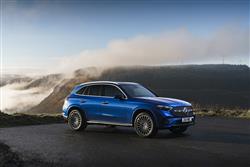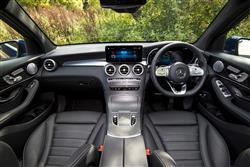How will you view?
This is a sample, showing 30 seconds of each section.
GLC-CHANGE? (some text hidden) SECTIONED_new_mercedesglc300e4matic_2023
By Jonathan Crouch
Mercedes' GLC 300 e 4MATIC plug-in Hybrid SUV offers a surprising set of stats. Jonathan Crouch drives it.
Ten Second Reviewword count: 40
The second generation Mercedes GLC 300 e sets new standards for what an upper mid-sized premium SUV Plug-in Hybrid can be. Thinking of choosing a full-EV of this kind in this class? Stop and consider this Mercedes before you do.
Backgroundword count: 145
Choosing your next business or family conveyance, particularly if it's a mid-sized premium SUV, can be a bit of a numbers game. If so, here are some numbers of interest, produced by this Mercedes GLC 300 e 4MATIC Plug-in Hybrid in second generation form; up to 80 miles of EV range, 565mpg on the combined cycle, 12g/km of CO2 and just 5% of Benefit-in-Kind taxation. There's a more off-putting sticker price number to go with all of these stats, but we'll get to that. For the time being, these figures vastly improve on what you'd get from this model's four main class rivals, Plug-in Hybrid versions of the BMW X3, the Audi Q5, the Volvo XC60 and the Jaguar F-PACE. And, unlike with those cars, with the GLC you can have a diesel plug-in powertrain as well as the petrol one we focus on here.
Driving Experienceword count: 412
As with the first generation GLC 300 e, a four cylinder petrol engine here is mated to an electric motor powered by a lithium-ion battery. It's that battery that's the biggest change with this second generation GLC Plug-in, more than doubled in size from 13.5kWh to 31.2kWh, which is pretty large for a PHEV. As is the resultant driving range figure - up to 80 miles. To give you some perspective, the previous generation GLC 300 e only went 27 miles on battery power alone. The equivalent C 300 e saloon has a smaller 25.4kWh battery, so only goes 68 EV miles between charges, so beyond mere practicality and fashion, there's plenty of justification for choosing the Crossover body style. If you want a Mercedes Plug-in of this size and are choosing between C-Class and GLC, there are other differences too. The rear-driven format of the C 300 e is replaced by a 4MATIC AWD system in the GLC. And, unlike the C-Class, the GLC Plug-in can also be had in diesel '300 de' form, if you don't mind a strike against the current zeitgeist and want even greater economy. It's the petrol GLC 300 e variant that's our focus here though which, like its diesel counterpart, gets a 134hp electric motor to assist the 2.0-litre combustion engine up-front. In the case of the GLC 300 e, that means a combined total output up at 308hp. Enough, even with this car's prodigious 2,355kg kerb weight, to dispatch 62mph in 6.7s en route to 135mph. Talking of weight, there's so much of it here that Mercedes has had to fit self-levelling air suspension at the rear to better control the extra bulk of the bigger battery pack. This damping set-up is more softly tuned than the sportier springing set-up used on more conventional GLC models, so the car feels less comfortable being thrown about - though few potential customers will want to do that anyway. What's of more interest here is to make the most of the efficient attributes of this clever powertrain. The car always defaults to full-electric EV mode if there's enough charge in the battery - and there usually will be because Mercedes has integrated a very effective brake regeneration system to replenish the system cells when slowing, braking or cruising. Only when you (or the car) switch to the Hybrid drive setting does the engine come into play, with smooth, seamless acceleration via the brand's usual 9-speed auto gearbox.
To see the full road test text contact us on 0330 0020 227
Pictures (high res disabled)
.jpg)
.jpg)
|
.jpg)
|
.jpg)
| |||
.jpg)
|
.jpg)
|
.jpg)
| |||
.jpg)
|
.jpg)
|

| |||
.jpg)
|
.jpg)
|
.jpg)
| |||
.jpg)
|
.jpg)
|

|
Statistics (subset of data only)
Min |
Max |
|
Price: |
£62,210.00 (At 21 Apr 2023) |
£72,210.00 (At 21 Apr 2023) |
Insurance group 1-50: |
47 |
48 |
CO2 (g/km): |
12 (WLTP) |
|
Max Speed (mph): |
135 |
|
0-62 mph (s): |
6.7 |
|
Electric WLTP-Rated Driving Range (miles): |
80 |
|
Combined Mpg: |
565 (SUV) |
|
Length (mm): |
4716 |
|
Width (mm): |
1890 |
|
... and 2 other stats available | ||
Scoring (subset of scores)
Category: Hybrid, Plug-in, Electric & Hydrogen
| Performance | |
| Handling | |
| Comfort | |
| Space | |
| Styling, Build, Value, Equipment, Depreciation, Handling, Insurance and Total scores are available with our full data feed. | |



